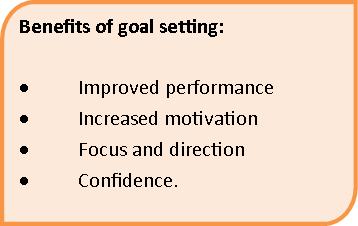If we want to succeed in any activity undertaken by us, we need to set goals. Without goals we lack focus and direction. Goal setting not only allows us to take control of our life’s direction; it also provides us a benchmark for determining whether we are actually succeeding.

To accomplish our goals, we need to know how to set them. Goal setting is a process that starts with careful consideration of what want to achieve, and ends with a lot of hard work to actually do it. In between there are some very well defined steps that transcend the specifics of each goal. Knowing these steps will allow us to formulate goals that we can accomplish.The human brain is set up to help you achieve goals that you sincerely believe are achievable.
Here are our five golden rules of goal setting:
1. Set Specific and Clearly Define Goals
Make sure your goals are concrete, concise and attainable.You should clearly define your business goals from the very start, which should be specific and well defined. The point is for you to articulate exactly what you want to achieve.
2. Set SMART Goals
We have heard of setting “SMART goals” already. But do we always apply the rule? Simple fact is that for goals to be powerful, they should be designed to be SMART. There are many variations of what SMART stands for, but the essence is this – goals should be:
- Specific.
- Measurable.
- Attainable.
- Relevant.
- Time Bound.
Your goal must be clear and well defined. Vague or generalized goals are unhelpful because they don't provide sufficient direction. Remember, you need goals to show you the way. Make it as easy as you can to get where you want to go by defining precisely where you want to end up.
Set Measurable Goals
Include precise amounts, dates, and so on in your goals so you can measure your degree of success. If your goal is simply defined as "To reduce expenses" how will you know when you have been successful? In one month's time if you have a 1 percent reduction or in two years' time when you have a 10 percent reduction? Without a way to measure your success you miss out on the celebration that comes with knowing you have actually achieved something.
Set Attainable Goals
Make sure that it's possible to achieve the goals you set. If you set a goal that you have no hope of achieving, you will only demoralize yourself and erode your confidence.
However, resist the urge to set goals that are too easy. Accomplishing a goal that you didn't have to work hard for can be anticlimactic at best,and can also make you fear setting future goals that carry a risk of
non-achievement. By setting realistic yet challenging goals, you hit the balance you need. These are the types of goals that require you to "raise the bar" and they bring the greatest personal satisfaction.
Set Relevant Goals
Goals should be relevant to the direction you want your life and career to take. By keeping goals aligned with this, you'll develop the focus you need to get ahead and do what you want. Set widely scattered and inconsistent goals, and you'll fritter your time – and your life – away.
Set Time-Bound Goals
You goals must have a deadline. Again, this means that you know when you can celebrate success. When you are working on a deadline, your sense of urgency increases and achievement will come that much quicker.
3. Set Goals In Writing
By clearly defining your idea, your imagination, heart and intellect can begin to work together to make it a reality.The physical act of writing down a goal makes it real and tangible. So, we should write our goals down.The act of writing our ideas down, or say, keying them into our laptop, will force us to think in concrete terms. It will also spark additional ideas. This is the birth of our action plan. And, goals are nothing more than what you “plan” to accomplish.
4. Make An Action Plan
The best, perhaps the only, way to turn an abstract goal into an attainable reality is to create an action plan. By writing out the individual steps, and then crossing each one off as we complete it,and with this we’ll realize that we are making progress towards your ultimate goal. However, we don’t need a complete plan in place to rise to the challenge and embrace its possibilities. Achieve greater success by continually updating our action plan and integrating the new information and ideas we uncover.
5. Stick With It!
Remember, goal setting is an ongoing activity not just a means to an end. Build in reminders to keep ourselves on track, and make regular time-slots available to review our goals. Our end destination may remain quite similar over the long term, but the action plan we set for ourselves along the way can change significantly. Make sure the relevance, value, and necessity remain high.
My other posts in this Blog on ACHIEVING GOALS :